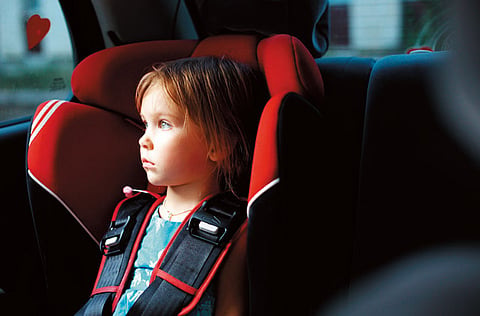Complete guide to child safety car seats in the UAE
Just how safe are your children when they're traveling in the car?

It goes without saying that one of the most important responsibilities you have as a parent is keeping your child safe when they’re riding in the car. Every year in the UAE there are a tragic number of cases of children who are killed or injured in car accidents. Despite the fact that there is no official law to the contrary, the proper use of car safety seats do help keep children safe.
According to Road Safety UAE, traffic accidents are the UAE’s Number One Infant Killer, with more than 62 per cent of infant mortality caused by some form of accident involving a car. This is not surprising, when apparently only 2 per cent of infants in the UAE are actually retrained in a proper car safety seat.
It is not uncommon to spot children crawling around a moving car in the UAE, and while such a thing is grossly irresponsible and potentially fatal, such a culture change isn’t going to happen overnight. There are several reasons why some parents don’t strap their children in securely, and one of those reasons is a general unawareness of what is available.
There are many different types of child safety seat available in the UAE. All budgets are catered for, and all of them will offer your most prized possession – your child – the safest means of transportation.
Read this guide to learn what child safety seat you need.
At a glance
Group 0 and Group 0+
Infants aged between birth and approximately 18 months should travel in Group 0 or Group 0+ seats. The only difference between the two is the physical size. Group 0+ seats are slightly larger, ideal for larger children up to 13kg, while the 0 takes a maximum child weight of 10kg.
Open this gallery for average prices of the various types of car seats.
Both seats types are rear-facing, which is the recommended way for babies to sit when in a car. Bases can be purchased which remain in the car permanently, meaning you can clip and unclip the car seat quickly and easily. You can, however, do without the base and secure the car seat with the conventional seatbelt.
Some models are even compatible with strollers, and can clip into them also.
Watch how this can be done in less than a minute
Group 1
Once a child has outgrown his or her rear-facing Group 0 or 0+ seat, they must graduate to a forward-facing Group 1 seat. Group 1 seats can be used for children from the age of 9 months to approximately 4-years. The recommended weight range is between 9kg and 18kg.
The seats are fixed onto the backseat of your car, and your child is strapped in securely. Seats in this category come with increased head and side-impact protection, ensuring that in the event of an accident your child will have the best chance of avoiding injury.
Group 2 and Group 3
Group 2 is a full booster seat complete with side cushions and side protection. You should use a Group 2 seat for children aged between 3 and 6-years, or who weigh between 15kg and 25kg. The seats are forward facing and remain fixed in the car. Strapping children in is not a time-consuming exercise.
Group 3 seats are simply booster seat bases and can carry children aged up to 12-years and a weight between 22kg and 36kg. In some cases, Group 2 booster seats convert into Group 3, which makes a lot of economical sense.
Sign up for the Daily Briefing
Get the latest news and updates straight to your inbox



